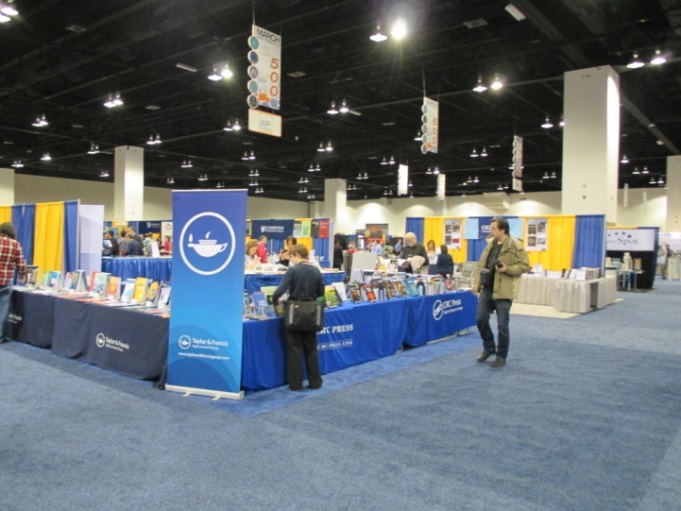Making friends at the APS March Meeting
American Physical Society March Meeting
March 3, 2014 to March 7, 2014
Denver, Colorado
Meeting host: By:Ashley Tucker
SPS Chapter:

The 2014 American Physical Society (APS) March Meeting was nothing short of overwhelming, but in the best way possible. Roughly 10,000 people and 6,000 talks is a lot to take in over the course of a week, especially considering this was my first conference of this scale. I was so excited when my professor asked me and two others from our research group at St. John’s University if we would like to go, and the meeting most certainly lived up to my expectations.
We flew to the conference on Sunday morning (March 2nd). Many of the other passengers on the flight were also headed to the conference and before we even arrived I could feel the energy. People were talking about where they were from and what research they were working on. When we arrived the conference had not officially started yet, but there were already events happening; a talk with astronauts from the International Space Station was held that evening.
After the talk my two colleagues and I went to a ‘Tweetup’ at a local dive bar/restaurant hosted by APS. We made name tags and grabbed a table. APS staff were handing out ‘Flat Fenymans’ (modeled on the popular Flat Stanley Project) and encouraging people to take Flat Fenyman on adventures and upload his pictures and tales on Twitter. We made an acquaintance who coincidentally is working in quantum computing research, the field one of my colleagues is going to graduate school for, reinforcing how important it is to reach out and talk to people at meetings. The next thing we knew, two more people joined our table, one from a national lab and the other a physical chemist. We conversed about our different interests, and several of us went out to dinner later. We learned so much from our new colleagues.
The next morning I went to check-in for the meeting and the line was so long it wrapped around the lobby–I could not believe it. After checking in I watched Orlando Lopez, a fellow student at St. John’s University, give our presentation on the synthesis of ZnO nanowires. The presentation was titled, “Effect of Substrate Annealing and Seeding on ZnO Nanowire Synthesized Using a Hydrothermal Method”, and it went well. Our talk had about twenty people in attendance and was well received.
At any given point in time there were dozens of talks happening at the meeting. Each talk in our session was ten minutes with questions taken at the end. The most intimidating part, I think, was anticipating that you might not be able to answer a question, but if you did your best it was largely well received. I knew the talks would be in-depth, and it can be difficult to follow some if you are unfamiliar with the research topic, but you don’t have to fully understand everything to learn something. Common themes among the student talks were nanomaterials and their applications, quantum computing, graphene, and industrial physics.
I thought the APS March Meeting was well catered to undergraduate students. On Monday there was a graduate school and job exposition with countless booths and refreshments. Everyone there was friendly and welcoming. It was really great to walk around, see all the displays, and talk to representatives of companies that interest me.
Monday night was the opening reception. There was a jazz band, bar, food, and tables spread throughout the ballroom. It was a really wonderful way to end the night.
I spent the entire day going to talks on Tuesday. There was an Industrial Physics Forum that included many talks that were a little different from the others, including a talk by an econophysicist who discussed cascading failures. I found this interesting because I had never given much thought to the physics behind the stock market. There were also cosmologists and astrophysicists at the conference, and I heard a talk on cosmic rays and another on the habitability of Mars. These talks were more generalized, meant for a wider audience, and had some variety. I especially appreciated these talks because my primary interest is in astrophysics, although that is not the research area I was working in at that time, so I was able to gain some insights into my desired field of study.
There was an awards ceremony and dance party for undergraduates on Tuesday night, complete with a bar, drinks, and food. It was a great time for the undergraduate students to really get to know each other and have a lot of fun doing so. Later that evening I went to a different bar with about five other undergraduate students and we ended up talking for about three hours–the time just flew by.
I headed back to New York Wednesday morning. I really learned a lot about physics and how to maneuver such a massive conference, which I think will get easier as I continue further into my career. I really encourage people to go to conferences and meetings related to their interests. While the events might feel overwhelming at times and some talks might be difficult to follow, you can still learn from the experience.
Areas of Alignment: Career Resources: Scientific Categories:


